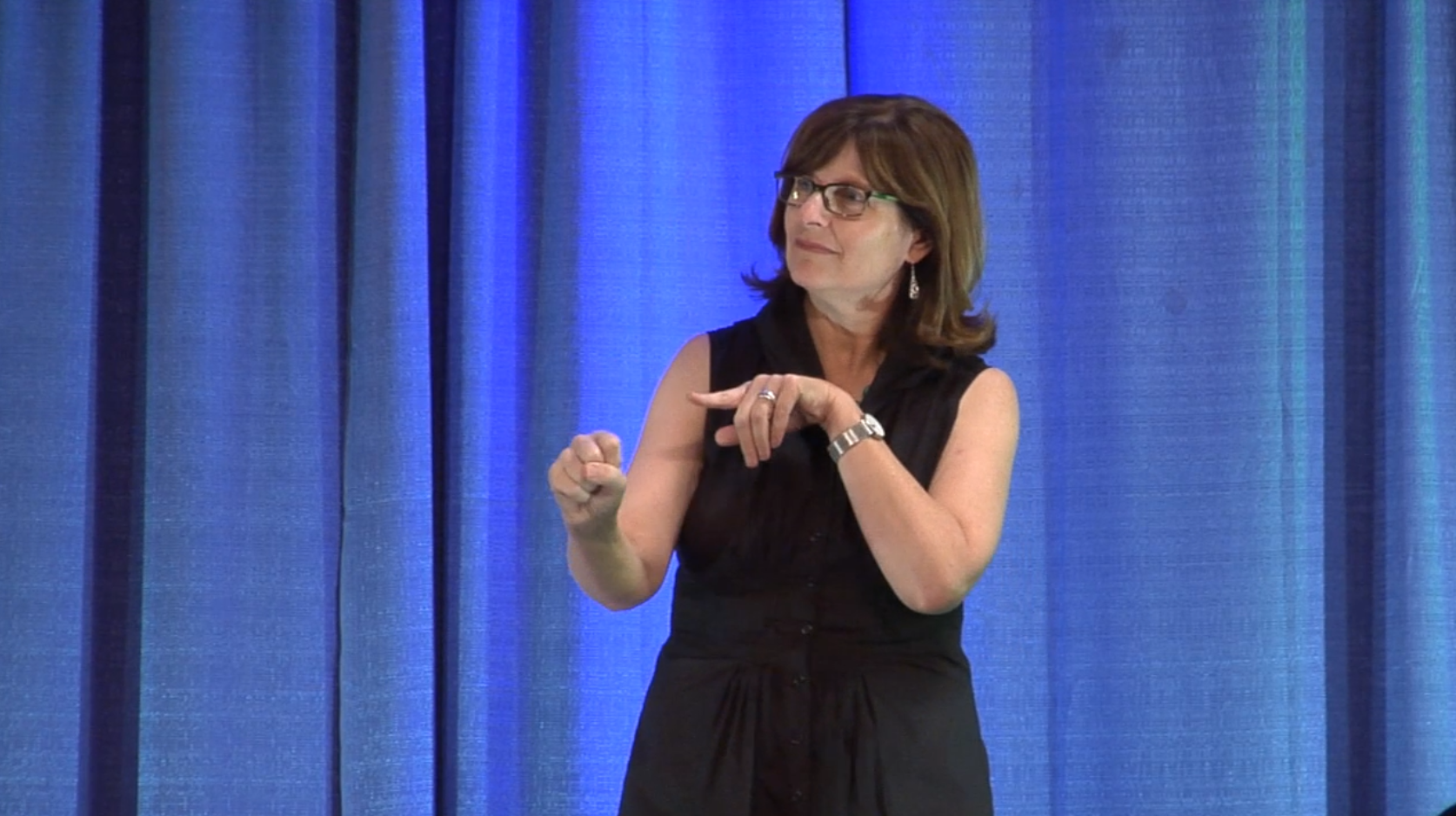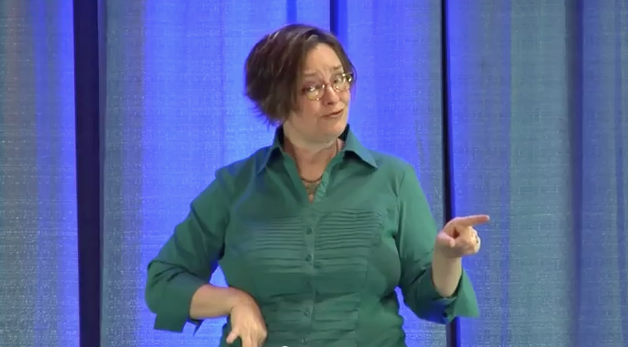
Denmark and Finland exemplify contrasting approaches to DIs and HIs. While roadblocks and resistance often hinder DIs in Denmark, having HIs and DIs study together in Finland leads to mutual cooperation.
Note: Anna Mindess, an American hearing interpreter wrote this post, incorporating interviews with Didde Nylander, a hearing Danish sign language interpreter and Markus Aro, a Finnish Deaf interpreter.
Looking through the eyes of people from other cultures, I believe, can provide a clearer perspective on our own situation. Recently, I’ve gotten a glimpse of two very different stances — regarding DIs and HIs — in Denmark and Finland. I hope sharing them will allow us to reexamine our own American struggles.
[Click to view post in International Sign Language]
Opening the Conversation
In 2008, I was invited to present several lectures in Denmark. For the last one, at the Deaf cultural center in the town of Castberggaard, before an audience of Deaf community members, I had the help of two wonderful Danish Deaf Interpreters, Bo Hårdell and Janne Niemelä. They translated my ASL into Danish SL so smoothly that I felt an effortless connection with my audience. On the train back to Copenhagen after the lecture, I thanked Bo and Janne again, adding that with their professionalism and language skills, they must surely receive many requests to work. They shook their heads and explained that in Denmark they felt their skills as DIs were not really appreciated. I was dismayed, but not that surprised, considering that many American DIs face the same challenges here.
A few months ago, I was contacted by a hearing Danish interpreter, Didde Nylander, who read my Street Leverage article Are Hearing Interpreters Responsible to Pave the Way for Deaf Interpreters? Didde is actively involved in furthering the goals of DIs in Denmark. She recounted a familiar narrative of Danish Deaf people explaining and clarifying for each other in school and later in Deaf Clubs; and also the hurdles they currently face trying to be accepted as professional interpreters.
A “Shadow Profession”: Challenges for Deaf Interpreters in Denmark
Denmark’s first official interpreter training program was established in 1986 and now hearing graduates can earn a professional degree. “But what about Deaf interpreters?” I asked Didde.
Didde: Until recently it has mainly been a ‘shadow profession’ operating below the awareness of most hearing interpreters and even most Deaf people, themselves. Even the Deaf professionals (e.g. teachers and social workers) who act as interpreters are not always aware that is what they are doing.
While it is clear that Deaf people are serving as interpreters in Denmark, Didde tells me they have been effectively barred from enrolling in the country’s only interpreter training program (ITP).
Didde: So far, Deaf people cannot be accepted because of a clause in the program description stating that ‘the aim is to train interpreters to work between spoken Danish and Danish SL.’ When two Deaf persons applied for the program in 2011, they were accepted but asked to wait a year so the program could adapt their curriculum. In 2012, however, the Ministry of Education rejected requests to change the curriculum for Deaf students, because they assumed that Deaf interpreting students could not complete the coursework on their own, but only if a hearing interpreter, in essence, did all the work for them. They likened it to a mute person who wanted to become an opera singer, but would need a speaking proxy to do the actual singing.
The training program finally proposed that the Deaf students could audit classes, but could not take the final exams, which meant they would not become ‘qualified interpreters’. The two DIs quit the program, then were accepted into EUMASLI instead. (European Masters in Sign Language Interpreting).
Hearing Interpreter Reactions in Denmark
I asked Didde about the majority of Danish HIs’ reactions to the unequal opportunities offered to DIs.
Didde: When they applied, these two interpreters, Vivien Batory and Bo Hårdell, had already been working as interpreters for about ten years for foreign visitors and at international conferences. But I don’t think most HIs even knew this took place, because we did not attend those events. The HIs who did attend were not concerned because these were not jobs we would have been assigned anyhow, since we did not know SLs other than Danish.
What did catch the HIs’ attention was when Vivien and Bo joined a team of HIs who had been interpreting television news broadcasts for several years. When their work became very visible, many HIs felt threatened.
Didde: Some HIs stated that they did not see the benefit of adding DIs, as they felt they were already doing a great job. Many took the position that they could not approve of DIs because they were not ‘trained.’ Fears multiplied: ‘Will the DIs take our work?‘ ‘Will we be ‘reduced’ to positions as feeders?’
As Danish Deaf interpreters increasingly worked in diverse settings, the Deaf community started to view interpretation as a viable profession for Deaf people. In 2012, the Deaf Association established a ‘DI project,’ in which 13 Deaf persons were given a course on interpretation and employed to work as freelance interpreters. They mainly worked in community settings, which made them more visible to HIs, which led to even more resistance within the HI community and emotional debates in our national interpreters’ association (the FTT).
In 2015, the national authority paying for community interpretations offered to certify the now 10 Deaf interpreters in the project, plus Vivien and Bo. So finally, Denmark has its first group of certified DIs, but that doesn’t mean they are fully accepted and equal to HIs. Currently, although several agencies have contracts with freelance DIs, they are certified to interpret only in pre-approved situations, which means a special application has to be made for each interpretation, explaining the exceptional need for a DI. And DIs still cannot take the full ITP.
Didde told me that earlier this year, there was much debate in FTT as to whether the certified Deaf interpreters could even become members. Some HIs supported the idea, while others were strongly against it. A large group was undecided. One concern Didde noted was, “whether we would need to use SL during our meetings. Many HIs say they are able to express themselves more freely in their first language, spoken Danish”. The issue of whether DIs can be members of FTT will be decided in a membership ballot this fall.
Didde: On an official level, we have come a long way. But has our cultural knowledge of Deaf people developed as completely? It seems to me that there is still a residue of old notions of Deaf people being inferior to the hearing majority and having limited professional options. The emergence of the DI profession has raised many attitudinal and cultural questions, which we need to examine with openness and curiosity. Our biggest challenge now is to secure a good relationship between HIs and DIs.
I told Didde I see several areas where DIs in the U.S. are ahead of those in Denmark, but at the same time, there is still resistance from certain HIs. Since I have heard similar stories regarding other countries, I hazarded a guess that this might be a worldwide phenomenon.
A Different Story in Finland
Didde corrected my overly broad assumption based on research she did in Finland, where a different path seems to have led to a more cooperative relationship between HIs and DIs. She suggested I interview Markus Aro, a Finnish Deaf Interpreter.
Markus shared with me that Finland has a history of using Deaf people to interpret for Deaf Blind people. In the 1980’s, there were not enough hearing interpreters to do tactile interpreting. So Deaf people were drafted. But the Deaf Blind consumers wanted their Deaf interpreters to get trained. The Finnish Association of the Deaf created a 175-hour course to train and certify a group of DIs in Deaf Blind interpreting.
Interpreter Education with HIs and DIs in Finland
Then, in 2001, when HUMAK (The University of Applied Sciences) announced that their four-year interpreter training program would welcome both Deaf and hearing students, the first six Deaf interpreters joined that program. Of the original six, four successfully completed the program, (Markus was one of them).
Besides trying to attract Deaf people into their program, HUMAK’s target group is hearing students with no experience in the Deaf community. Markus told me that most hearing students enter HUMAK at 19-20 years old, without knowing sign language. Since the HIs come in with little or no previous knowledge about Deaf people and then are thrust into a collaborative learning environment with Deaf students also studying to become interpreters, they learn “good attitudes” from the beginning and early on get used to working with Deaf interpreters. While the hearing students spend much of their first two years learning Finnish Sign Language, the Deaf students focus on written Finnish and English.
Markus: The courses for Deaf and hearing students differ only slightly. They try to make as few adjustments as possible so all students receive the same education. Linguistics is taught separately to hearing and Deaf students, but they have many courses together, such as Interpretation Theory. The third and fourth years focus on interpreting skills for all students. There is a folk high school for Deaf immigrants, in the same location as HUMAK, where the Deaf students practice interpretation with the immigrant students.
“It was a good experience studying together with HIs, “ Markus told me. “And we figured out how to team together.”
Markus: When I studied at HUMAK, there hadn’t yet been a lot of analysis of best practices for HI and DI teams. The teachers informed us that we would just have to work it out together. We told the HIs we didn’t just want them to be ‘mindless feeders.’ It’s all about teamwork and the need to keep checking in and seeing how to support each other.
Community Buy-In is Key
After graduating, however, the DIs found there was not much work for them.
Markus: Part of the problem was a feeling among the Deaf Community, ‘Why do we need Deaf interpreters?’ So we explained about Deaf blind, International Sign, translation from written Finnish into SL and immigrants. Gradually, the Deaf Community became more open and after a couple of years their attitude was much more positive. Most of the HIs were happy to work with DIs, but a few had some resistance.
Ironically, a shortsighted governmental policy helped some HIs appreciate DIs’ valuable skills. In 2012, the Finnish government (who pays for the majority of interpreting services) declared that Deaf immigrants would only be entitled to DI services for one year, assuming that after a year, the immigrants would learn enough Finnish SL that HIs alone could satisfy their communication needs.
Markus: After the one-year mark, HIs found themselves on their own with these Deaf immigrants, wishing the DIs could come help them interpret. If, however, these immigrants went to a police station or a hospital, those entities can pay for Deaf interpreters from their own funds. Then the HIs were again relieved and grateful for DIs’ help.
Markus concludes: “We need HIs! We can’t work without them. We need to work together so Deaf people get the best access.”
In Conclusion
I think there is much we can learn from these two narratives. Markus credits the fact that HIs start HUMAK with a “blank slate” of no previous knowledge of sign language or Deaf Culture as being key to their openness to learning together with Deaf colleagues. Meanwhile, in North America, we seem to be pushing for a higher bar of language and cultural competency as prerequisites for entering ITP students.
Acknowledgements
**This article and its ASL and IS translations were made possible thanks to the contributions of many people across the world: Didde Nylander, Markus Aro, Ryan Shephard, Nana Marie Søltoft, Bo Hårdell, Tegnsprogstolken.dk, the Danish Deaf Association and Damon Timm.
Questions for Consideration
1) Which do you think is the best approach?
2) Is this a generational issue? (i.e., when many of us older interpreters were trained, there were no “Deaf Interpreters” so it may seem jarring to introduce a whole new element into an established system –even though Deaf people have been “interpreting for each other” forever? Will the younger generation have an easier time accepting Deaf interpreters?
3) For readers from other countries, what is your experience in training Deaf and Hearing interpreters? Any tips for us?












